Are you planning a trip to the Philippines? Get ready to face a traffic challenge like no other. With hectic traffic, bad roads, and limited public transport options, traveling around the country can be a daunting task. But fear not! In this article, we will provide you with tips and insights to help you navigate the traffic jungle and make your journey smoother and more enjoyable. So, buckle up and get ready to explore the beautiful islands of the Philippines!
Key Takeaways:
- Understanding the transportation options and finding the most efficient ways to get around is crucial in the Philippines.
- Manila’s three elevated rail systems – LRT1, LRT2, and MRT3 – provide a cheap and efficient way to travel within the city.
- Buses are the primary mode of regional travel due to the limited rail network.
- Renting a car is not recommended due to heavy traffic and poor road conditions. Taxis are a safer and more convenient option for day trips within cities.
- Jeepneys, converted US-military jeeps turned into buses, are a popular but crowded and uncomfortable mode of transportation in urban areas.
The Rail System in Manila and Beyond
The Philippines has a limited rail system, but Manila’s three elevated rail systems offer a convenient and affordable means of transportation. The three systems are the LRT1, LRT2, and MRT3, which provide efficient connectivity within the city and beyond. The rail services are equipped with modern facilities and are known for their punctuality.
Visitors and locals alike can make use of the Beep Card, a contactless payment card that allows for seamless transactions on all three rail services. This eliminates the need for carrying cash and makes the journey more convenient. The Beep Card can be easily topped up with funds and offers competitive fares.
However, it’s important to note that the rest of the country has minimal railway infrastructure. As a result, buses are the primary mode of transportation for regional travel. These buses connect various cities and towns, offering a cost-effective and relatively efficient option for exploring different parts of the Philippines.
Comparison of Manila’s Rail Systems:
| Rail System | Route | Stations | Operating Hours | Fare Range |
|---|---|---|---|---|
| LRT1 | Baclaran to Roosevelt | 20 | 5:00 AM – 9:30 PM | P15-P30 |
| LRT2 | Recto to Santolan | 11 | 5:00 AM – 9:30 PM | P12-P25 |
| MRT3 | North Avenue to Taft Avenue | 13 | 5:30 AM – 10:30 PM | P13-P30 |
The table above provides an overview of the different rail systems in Manila, including their routes, number of stations, operating hours, and fare ranges. It allows passengers to compare and choose the most suitable option based on their travel needs.
“The rail systems in Manila offer a reliable and efficient way to navigate the city’s traffic. With the convenience of the Beep Card and affordable fares, commuters can enjoy a hassle-free journey.” – Juan Dela Cruz, Local Resident
While the rail systems in Manila provide a convenient mode of transportation for commuters within the city, it’s important to note that they do not cover all areas of the Philippines. For regional travel, buses remain the primary choice, offering connectivity to different provinces and towns.
Buses in the Philippines
When it comes to regional travel in the Philippines, buses play a crucial role due to the limited rail network. While the quality of bus services may vary, some premium buses offer comfort, convenience, and additional amenities such as free Wi-Fi and onboard toilets. These features aim to enhance passengers’ overall experience and make their journey more enjoyable.
However, it’s important to consider the challenges that come with bus travel in the country. Traffic congestion is a significant issue, particularly in urban areas, impacting the speed and efficiency of bus journeys. Even for relatively short distances, poor roads can further contribute to delays and make bus travel slow and time-consuming.
“Traffic congestion and poor roads make bus journeys in the Philippines slow and time-consuming.”
Despite these challenges, buses remain a popular and affordable mode of transportation for both locals and tourists. For those willing to embrace the adventure and experience the local way of getting around, buses offer a unique opportunity to immerse oneself in the Filipino culture and interact with fellow passengers.
Here is a comparison of the pros and cons of bus travel in the Philippines:
| Advantages | Disadvantages |
|---|---|
|
|
Ultimately, the decision to travel by bus in the Philippines depends on personal preferences and priorities. It’s important to be prepared for potential delays and consider alternative transportation options if time constraints are a concern.
Safety Tips for Bus Travel in the Philippines
While bus travel can be a convenient and cost-effective option, it’s important to prioritize safety. Here are some safety tips to keep in mind:
- Secure your belongings and keep them within sight at all times.
- Stay vigilant and be aware of your surroundings, especially in crowded bus terminals or during boarding and alighting.
- Choose reputable bus operators with a good safety track record.
- If possible, avoid traveling during late hours when bus terminals and surroundings may be less secure.
- Follow local traffic regulations and practice caution while on the road.
By following these safety measures, passengers can enjoy a worry-free journey and make the most of their bus travel experience in the Philippines.
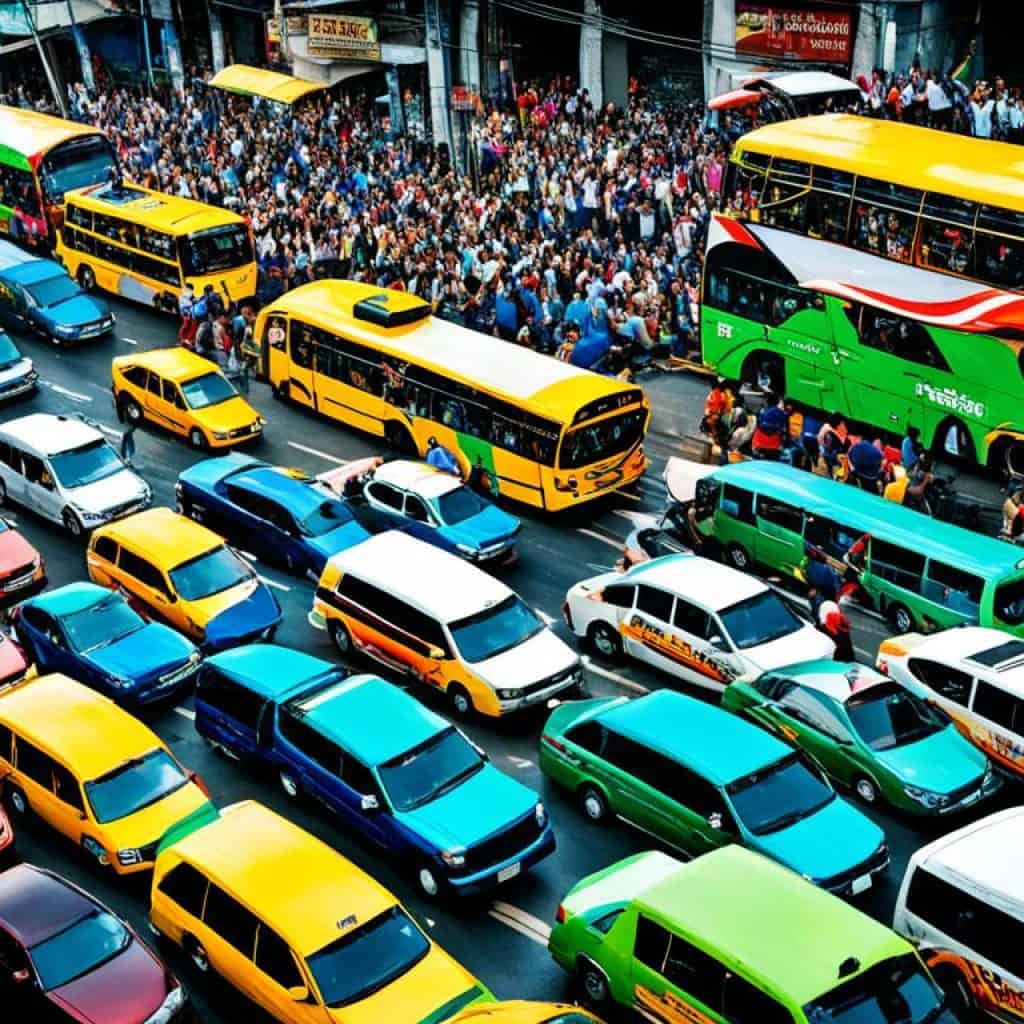
Renting a Car vs. Taking Taxis
When it comes to getting around in the Philippines, should you rent a car or rely on taxis? Let’s explore the options and consider the traffic rules in the country.
Renting a Car
Renting a car may seem like a convenient choice for exploring the Philippines at your own pace. However, it’s important to note that heavy traffic and poor road conditions can make driving in the country challenging. Additionally, road safety concerns, including reckless driving and a lack of proper enforcement, can further add to the risks associated with renting a car.
“Renting a car in the Philippines is not recommended due to heavy traffic, poor road conditions, and road safety concerns.”
Taking Taxis
On the other hand, relying on taxis for day trips within cities can provide a safer and more convenient option. Regular taxis in the Philippines are affordable, comfortable, and offer a level of privacy. By choosing taxis, you can avoid the stress of navigating through congested roads while enjoying the convenience of reaching your destination directly.
It is worth noting that taxi scams can occur in some areas of the Philippines. To avoid any issues, it is advisable to use reputable taxi services or ride-hailing apps like Grab. These platforms provide a reliable and secure way to travel around the cities without worrying about being overcharged or taken to incorrect destinations.
“Relying on taxis for day trips within cities can provide a safer and more convenient option. Regular taxis in the Philippines are affordable, comfortable, and offer a level of privacy.”
Jeepneys as an Option
If you’re looking for an affordable mode of transportation in urban areas of the Philippines, jeepneys can be a viable option. These iconic vehicles, originally converted from US-military jeeps, are a popular choice among locals and tourists alike.
Are Jeepneys a good option?
- Jeepneys are known for their low fare, making them a budget-friendly choice for short trips within the city.
- They are widely available throughout urban areas, ensuring convenient access to various destinations.
- Jeepneys often follow established routes, providing a degree of predictability in terms of travel.
However, it’s important to consider some drawbacks when considering jeepneys as a transportation option:
- Jeepneys can become overcrowded during peak hours, making the journey uncomfortable for passengers.
- Due to the open design of the vehicles, passengers may be exposed to exhaust fumes and the elements.
- While cheap, the affordability of jeepneys comes at the expense of comfort and convenience.
If you don’t mind the occasional crowded and uncomfortable ride, jeepneys can be a good option for short-distance travel within urban areas of the Philippines.
To give you a better idea of what to expect, here’s a quote from a local commuter:
“Jeepneys are a staple in Philippine transportation. They may not be the most comfortable option, but they are undeniably part of our culture. If you’re up for a unique experience and want to immerse yourself in the local way of getting around, hop on a jeepney!”
If you’re interested in visualizing a typical jeepney, take a look at the image below:
While jeepneys have their pros and cons, it’s essential to weigh your options and consider your comfort preferences before deciding if they are the right fit for your transportation needs in the Philippines.
Motorbike Taxis and Tricycle Taxis
When it comes to getting around in the Philippines, motorbike taxis and tricycle taxis are commonly used for short trips. They offer convenience and flexibility, especially in crowded urban areas. However, it’s important to consider the risks and limitations associated with these modes of transportation.
Motorbike taxis, also known as habal-habal or motorcycle taxis, are popular for their ability to weave through traffic and provide quick transport. They can be a convenient option for reaching your destination faster, especially during peak hours. However, it’s essential to note that motorbike taxis can be risky, primarily due to the lack of passenger helmets and potentially erratic driving behavior.
For those looking for a safer alternative, tricycle taxis are a viable option. These three-wheeled vehicles consist of a motorcycle with a sidecar, providing a more stable and secure ride. Tricycle taxis are particularly common in smaller towns and rural areas, where they serve as the primary mode of transport.
While tricycle taxis offer a safer option compared to motorbike taxis, it’s important to manage your expectations in terms of comfort and reliability. The compact size and limited seating capacity of tricycles make them less spacious and comfortable compared to regular taxis. Additionally, tricycle availability may vary depending on the area and time of day, so it’s advisable to have a backup plan in case they are not readily accessible.
Overall, motorbike taxis and tricycle taxis can be convenient options for short trips in the Philippines. Motorbike taxis offer speed and agility, while tricycle taxis provide a safer alternative with their unique setup. However, keep in mind the potential risks and limitations associated with these modes of transportation, and always prioritize your safety.
To give you a clearer picture, here’s a comparison between motorbike taxis and tricycle taxis:
| Motorbike Taxis | Tricycle Taxis |
|---|---|
| + Quick and efficient | + Safer option |
| + Ability to navigate through traffic | + More stable and secure ride |
| – Lack of passenger helmets | – Limited seating capacity |
| – Potentially erratic driving | – Less spacious and comfortable |
Key Takeaways:
- Motorbike taxis provide quick transportation but come with risks such as lack of passenger helmets and potentially erratic driving behavior.
- Tricycle taxis offer a safer alternative with their motorcycle and sidecar setup, but they may be less spacious and comfortable compared to regular taxis.
- Consider the limitations and potential risks associated with motorbike taxis and tricycle taxis before opting for them as your mode of transportation in the Philippines.
Traffic Situations in Manila
Manila, the capital city of the Philippines, is notorious for its nightmarish traffic conditions. In fact, it ranks as one of the cities with the worst traffic globally. Navigating through Manila’s congested streets can be overwhelming, especially during rush hour.
The traffic situation in Manila is not limited to specific hours of the day; it can be unpredictable throughout the day. The city’s main thoroughfare, EDSA, is often plagued with heavy traffic congestion, leading to significant delays in reaching your destination.
Planning ahead and allowing ample time for travel is crucial when navigating Manila’s traffic. Whether you are commuting to work, going on a sightseeing tour, or heading to the airport, it’s essential to factor in the potential delays caused by the city’s traffic.
Below is an overview of the traffic conditions in Metro Manila, including the EDSA traffic update:
Metro Manila Traffic Report
| Time Range | Traffic Condition |
|---|---|
| Midnight to early morning | Light traffic |
| Morning rush hour (6:00 AM – 9:00 AM) | Heavy traffic; significant congestion |
| Mid-morning to early afternoon | Moderate traffic |
| Afternoon rush hour (5:00 PM – 8:00 PM) | Heavy traffic; significant congestion |
| Late evening | Light to moderate traffic |
Understanding the traffic patterns and planning your schedule accordingly can help minimize the impact of Manila’s traffic on your daily commute or travel plans. Consider utilizing alternative routes or adjusting your departure time to avoid peak traffic hours whenever possible.
“Manila’s traffic can be challenging, but with careful planning and patience, you can still enjoy exploring this vibrant city.”
Remember, staying updated with the latest EDSA traffic update and following local traffic reports can provide valuable insights for your journey through Metro Manila.
Safety on Public Transport
When traveling on public transport in the Philippines, it is important to prioritize your safety. Unfortunately, pickpocketing and robbery incidents are common in Philippine cities. However, by taking some simple precautions, you can help protect yourself and your belongings, ensuring a safer journey.
Keep Valuables Secure
One of the key steps in safeguarding your belongings is to keep them secure at all times. Here are some tips to help protect your valuables:
- Keep your bags, wallets, and phones close to your body.
- Use bags with secure closures such as zippers or buckles.
- Avoid displaying expensive jewelry or electronics.
- Be cautious when using your phone or other devices in public.
Stay Alert and Aware
Remaining alert and aware of your surroundings is crucial in ensuring your safety. Here are some strategies to help you stay vigilant:
- Be mindful of crowded areas, as they can provide cover for thieves.
- Pay attention to individuals who appear suspicious or overly interested in your belongings.
- Trust your instincts and avoid situations or individuals that make you feel uncomfortable.
- Stay updated on the latest safety information and advisories for your destination.
“It’s better to be safe than sorry. Always prioritize your safety when using public transport in the Philippines.”
By following these safety measures and exercising caution, you can greatly reduce the risk of theft and ensure a safer journey on public transport. Remember, taking proactive steps to protect yourself and your belongings is essential in enjoying a hassle-free experience while exploring the Philippines.
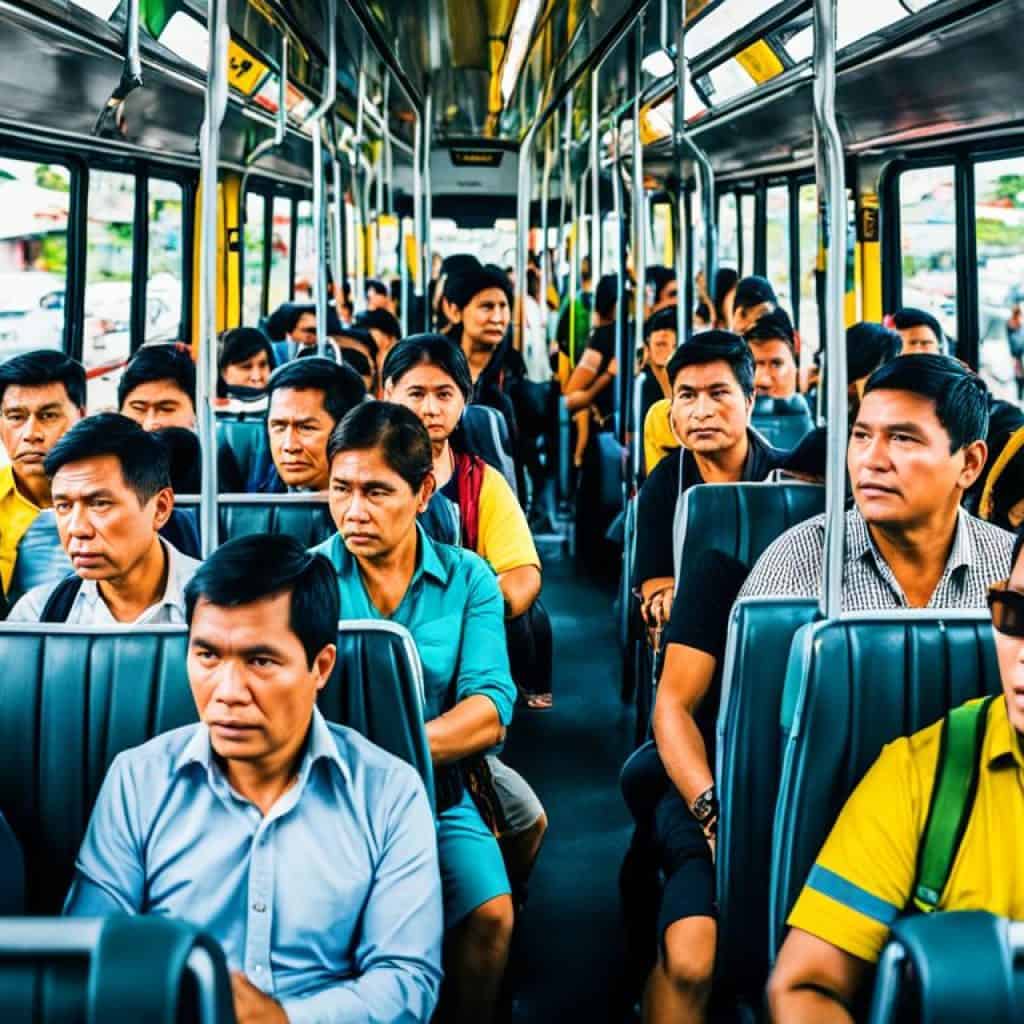
Acknowledging Help From Others
It’s worth mentioning that asking locals or seeking guidance from authorities can provide valuable insights and further enhance your safety. Locals often have firsthand knowledge of the safest routes or any specific precautions to take in certain areas, and authorities can provide assistance or advice when needed.
Renting Bicycles
Thinking of renting bicycles in the Philippines?
While it may sound like an appealing option for exploring the country, there are a few factors to consider before hopping on a bike. The lack of dedicated cycle paths and the condition of roads can make cycling challenging and potentially unsafe.
However, if you’re an experienced cyclist looking for an adventurous way to navigate the Philippines, there are dedicated cycle shops available in tourist areas. These shops offer a variety of bicycles for rent, catering to different preferences and skill levels.
Before renting a bicycle, it’s important to assess the road conditions and traffic in the specific area you plan to explore. Some regions may have better infrastructure and less congested roads, making cycling a more viable option. Researching local traffic conditions and seeking advice from locals or fellow cyclists can provide valuable insights.
Remember to prioritize safety:
- Wear a helmet at all times to protect your head in case of accidents.
- Be cautious of motorists and follow traffic rules to ensure your safety on the road.
- Take extra care when cycling in high-traffic areas or during peak hours.
If you do decide to rent bicycles in the Philippines, make sure to take it slow and enjoy the scenic beauty of the country. Cycling can be a unique and rewarding way to explore the Philippines, allowing you to immerse yourself in the local culture and discover hidden gems along the way.
| Renting Bicycles in the Philippines | Considerations |
|---|---|
| Cycle Shop Locations | Tourist areas |
| Type of Bicycles | Various options for different preferences and skill levels |
| Road Conditions | Varying quality, may have uneven surfaces and potholes |
| Traffic | Can be congested, especially in urban areas |
| Safety Precautions | Wear a helmet, follow traffic rules, be cautious of motorists |
Domestic Air Travel
When it comes to traveling within the Philippines, domestic air travel offers a convenient and affordable option. With an extensive network of airports, including Manila’s bustling international airport, travelers can easily fly to various regional destinations, saving time and bypassing the notorious Metro Manila traffic.
One of the major advantages of domestic air travel is the availability of budget airlines that offer low-cost fares. These airlines provide an attractive alternative for long-distance travel within the country, allowing travelers to reach their destinations swiftly and comfortably.
Whether you’re planning a beach getaway in Boracay or exploring the stunning landscapes of Palawan, hopping on a domestic flight can significantly reduce travel time and enhance your overall experience. Plus, with a range of flight options available, you can easily find flights that fit your schedule and budget.
If you’re flying from or to Manila, which hosts the primary international airport, you’ll benefit from the well-connected domestic flight routes. This is particularly advantageous for travelers who want to explore multiple destinations in the Philippines without spending hours on the road.
Benefits of Domestic Air Travel in the Philippines:
- Saves time and helps avoid traffic congestion in Metro Manila
- Affordable fares, especially with budget airlines
- Extensive network of airports for easy access to regional destinations
- Multiple flight options to accommodate different schedules
Airlines operating domestic flights in the Philippines include Philippine Airlines, Cebu Pacific, AirAsia Philippines, and many others. These airlines offer a range of services and amenities to ensure a comfortable journey for their passengers.
When planning your trip, be sure to check the flight schedules, book in advance to secure the best fares, and arrive at the airport with ample time for check-in and security procedures.
| Airline | Website | Fare Range |
|---|---|---|
| Philippine Airlines | www.philippineairlines.com | $50 – $300 |
| Cebu Pacific | www.cebupacificair.com | $30 – $200 |
| AirAsia Philippines | www.airasia.com | $20 – $150 |
Traveling Made Easy with Domestic Flights
Domestic air travel in the Philippines provides a seamless and stress-free way to explore the archipelago. So buckle up, relax, and let the friendly skies take you to your dream destinations.
Coach Buses as City-to-City Transportation
Coach buses play a crucial role in intercity travel within the Philippines, offering a reliable and extensive network for commuters. While the light rail system in Manila has its limitations, coach buses provide an efficient alternative for long-distance journeys.
Many bus companies in the Philippines understand the importance of passenger comfort and strive to offer amenities that enhance the travel experience. Some coaches provide spacious seating, air conditioning, and onboard entertainment systems. These features allow passengers to relax and enjoy their journey while heading to their desired destination.
“Coach buses provide a comfortable and convenient way to travel between cities in the Philippines. The spacious seating and amenities onboard make the journey enjoyable.”
However, it’s essential to note that traffic congestion and road conditions can impact the overall travel experience. The Philippines, like many countries, faces traffic congestion issues, especially in urban areas. Delays caused by traffic can affect the punctuality of coach buses and increase travel times.
Despite these challenges, coach buses remain a popular choice for intercity travel due to their affordability, convenience, and extensive coverage. Travelers can rely on bus schedules and routes to plan their trips, offering flexibility and accessibility to various destinations throughout the country.
Advantages of Coach Buses:
- Extensive network for intercity travel
- Affordable fares
- Amenities such as spacious seating and air conditioning
- Flexibility in choosing departure times
- Accessible for both urban and rural areas
While coach buses provide a comfortable and accessible means of transportation, it’s important for travelers to consider potential delays caused by traffic congestion. Planning ahead and allowing extra time for travel can help mitigate these challenges and ensure a smoother journey.
| Advantages | Disadvantages |
|---|---|
| Extensive network | Potential delays due to traffic congestion |
| Affordable fares | Varied road conditions |
| Comfortable amenities | Longer travel times |
| Flexible departure times | – |
| Access to urban and rural areas | – |
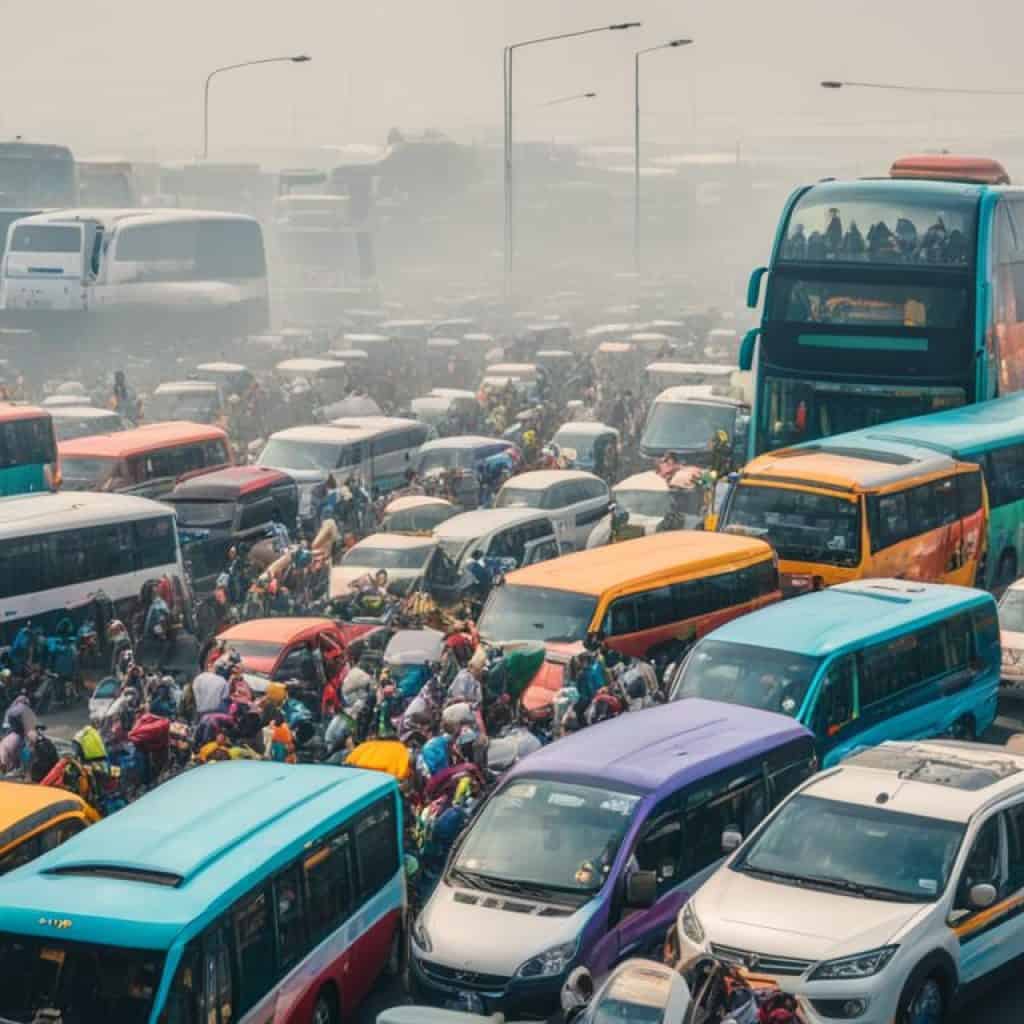
Despite the challenges posed by traffic congestion and road conditions, coach buses remain a reliable and effective mode of transportation for traveling between cities in the Philippines.
Ferries for Island-Hopping
When it comes to exploring the remote beach islands of the Philippines, taking a ferry is a popular choice. With numerous ferry companies operating between islands, it offers an alternative to domestic flights. Whether you’re island-hopping in Palawan, Cebu, or Bohol, ferries provide a scenic and enjoyable way to travel.
But why choose ferries over other forms of transportation? The answer lies in the breathtaking views, the flexibility to visit multiple islands, and the immersive experience of sailing through the crystal-clear waters of the Philippine archipelago. Avoid the traffic congestion on land and embark on a maritime adventure instead.
Before booking your ferry tickets, it’s important to do some research and choose reputable ferry companies to ensure a safe and seamless island-hopping experience. Look for companies with a proven track record of reliability, safety, and excellent customer service. Reading reviews from fellow travelers can also provide valuable insights into the quality of service.
Additionally, consider the following factors when planning your ferry trips:
- Availability and frequency of ferry schedules
- Travel duration between islands
- Onboard amenities and facilities
- Comfort level, including seat options and air conditioning
- Ticket prices and possible discounts
By taking these factors into account, you can make informed decisions and choose the best ferry options for your island-hopping adventure.
“The sea, once it casts its spell, holds one in its net of wonder forever.” – Jacques-Yves Cousteau
Immerse yourself in the beauty of the Philippine islands by taking the ferry and exploring the stunning beach destinations that await. Embark on unforgettable journeys, discover hidden gems, and create lasting memories as you sail through the turquoise waters.
Benefits of Taking Ferries for Island-Hopping
Taking ferries for island-hopping offers a range of benefits:
- Flexibility: Ferries provide the flexibility to create your own itinerary, allowing you to visit multiple islands at your own pace.
- Breathtaking Views: Enjoy stunning coastal landscapes, picturesque islands, and mesmerizing sunsets as you sail between destinations.
- Escape Traffic Congestion: Avoid the hustle and bustle of city traffic and experience a more relaxed and scenic mode of transport.
- Affordability: Ferry tickets are often more budget-friendly compared to domestic flights, making it an accessible option for travelers.
- Opportunity for Exploration: Discover hidden coves, pristine beaches, and remote islands that may not be easily accessible by other means of transport.
So, pack your sunscreen, a good book, and your sense of adventure, and get ready to embark on an incredible island-hopping journey through the Philippines’ tropical paradise.
Taxis and Alternative Transportation Options
When it comes to getting around in the Philippines, taxis are a popular choice for both locals and tourists. With their convenience and availability, taxis offer a reliable way to navigate through the bustling streets. However, it’s important to be cautious of potential scams and unscrupulous drivers.
Tip: Always use licensed taxis and ensure that the meter is used to calculate the fare accurately.
For a more convenient and reliable option, ride-hailing apps like Grab have gained immense popularity in the Philippines. With just a few taps on your smartphone, you can easily book a ride and have peace of mind knowing the price upfront. Grab also provides additional safety features, such as driver tracking and in-app emergency assistance.
While taxis and ride-hailing apps offer convenience and reliability, there are also alternative transportation options to explore in the Philippines.
Jeepneys
A unique mode of transportation in the Philippines is the iconic jeepney. Originally repurposed from US military jeeps after World War II, jeepneys have become a popular way to get around in urban areas. These vibrant and colorful vehicles can be quite an experience, but they are often crowded and uncomfortable.
Jeepneys may not provide the most comfortable or efficient ride, but they offer a glimpse into the vibrant local culture of the Philippines.
Tricycles
Another popular mode of transportation, especially in smaller towns and rural areas, are tricycles. These three-wheeled vehicles, consisting of a motorcycle and sidecar, are a common sight across the country. While they may not be the fastest or most spacious option, tricycles provide a convenient way to navigate narrow streets and reach nearby destinations.
Pedicabs
In some areas, especially in tourist spots and local neighborhoods, pedicabs offer a unique and eco-friendly transportation experience. Pedicabs are bicycle-powered tricycles, where passengers sit in a small carriage attached to the front of the bike. While they may not be suitable for long journeys, pedicabs provide a leisurely way to explore the surroundings at a slower pace.
| Transportation Option | Pros | Cons |
|---|---|---|
| Taxis | – Widely available – Convenient – Can hail on the street |
– Potential scams – Traffic delays – Variable fare rates |
| Grab | – Convenient booking via app – Upfront pricing – Safety features |
– Surge pricing during peak times – Limited availability in some areas |
| Jeepneys | – Provides a unique cultural experience – Affordable fares |
– Overcrowded – Uncomfortable – Limited routes |
| Tricycles | – Convenient for short distances – Accessible in smaller towns |
– Slow speed – Limited capacity |
While taxis remain a popular choice, exploring alternative transportation options such as jeepneys, tricycles, and pedicabs can add a touch of adventure and local flavor to your journey in the Philippines.
Conclusion
Navigating traffic in the Philippines can be a daunting task, but with careful planning and the right transportation choices, travelers can have a smoother journey. Traffic congestion, poor road conditions, and limited transport options can make getting around a challenge, but there are ways to mitigate these issues.
To overcome the traffic in the Philippines, it is crucial to plan ahead and allow extra time for travel. Research the various transportation options available, such as the rail system in Manila, buses, taxis, jeepneys, tricycles, and motorbike taxis. Each mode of transport has its pros and cons, so choose the one that suits your needs and preferences.
In addition, utilizing reliable transportation modes, such as taxis or ride-hailing services like Grab, can help ensure a safer and more efficient journey. Be mindful of your safety while using public transport and take necessary precautions, such as keeping valuables secure and staying alert.
Remember, understanding the traffic situation in Manila and being prepared for delays can help alleviate frustrations. By following the tips and insights provided in this article, you can make the most of your time in the Philippines and have a smoother travel experience despite the traffic congestion.
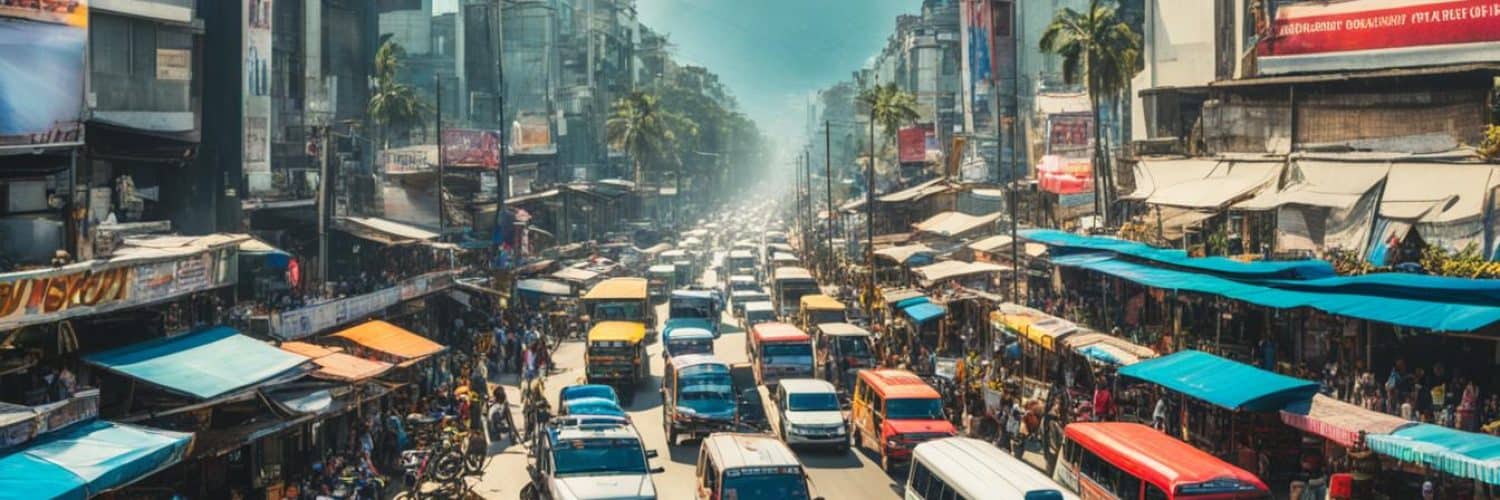


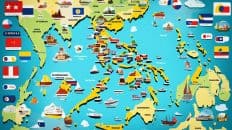










Add comment